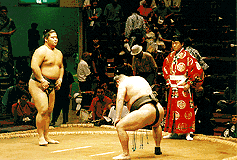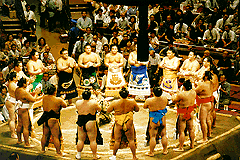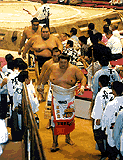Sumo - Traditional Japanese Wrestling
Sumo: Introduction | The Basics | The Basho | The Hanada Dynasty
The Basho
There are six basho (tournaments) a year, held every odd month in Tokyo (Jan, May and Sept), Osaka (Mar) Nagoya (Jul) and Kyushu (Nov). The Tokyo basho are held at the Kokugikan in Ryogoku. In recent years, sumo has lost some of the popularity it enjoyed in the 1990s so that tickets are not usually sold out. Same-day tickets can often be bought for the first ten days or so of the 15-day basho and advance tickets are even easier to get. Unfortunately, you'll have to go to the venue to buy them. If you're really stuck, ticket touts are usually somewhere in the area - they'll find you if you look desperate for a ticket. Towards the end of the 15 days, the tension builds and tickets become harder to find as rikishi (wrestlers) try for their kachikoshi (winning record) or vie for the yusho (championship).

Makushita rikishi warm up

The bow-twirling ritual
The basho day starts early, with maezumo (apprentices) fighting in the morning before the four junior divisions (who only fight on 7 of the 15 days) take to the dohyo (ring). While the next division, the juryo are fighting, the crowd begins to build until about 4pm when the dohyoiri (ring-entrance ceremonies) for the highest division - 30 makuuchi rikishi, the sanyaku (three top ranks) and the yokozuna (grand champions) - signal the main bouts of the day. These top-ranked sekitori wear colorful, hand-made silk kesho-mawashi (aprons) paid for by sponsors or fans.
Before each bout, the two rikishi step up onto the dohyo and a yobidashi (steward) calls out their names. The rikishi throw some salt into the 4.6 meter ring on the dohyo to purify it before entering. They then perform some movements which symbolize their lack of weapons, leave the ring and enter again, usually twice more. The gyoji (referee) adopts a different stance when the preparation time is up. Despite all the elaborate ceremony surrounding the sport, sumo is surprisingly simple. The two rikishi face each other behind their shikirisen (starting line) in the center of the dohyo and when both are ready, they touch the dohyo with both hands and charge. If one rikishi charges before the other is ready, there is a matta, meaning the bout is stopped, the rikishi warned (and fined ¥30,000!) and the bout restarted. The first to touch the dohyo with any part of the body other than their feet or to step out of the ring loses. As even the slightest touch of the dohyo outside the ring means a defeat, the clay is carefully brushed smooth before each bout. Sometimes there is uncertainty about which rikishi stepped out or touched the dohyo first. In this case, the five shimpan (judges) sitting around the dohyo gather for a monoii or consultation before deciding the winner or declaring a rematch.
The final bouts are always the sanyaku and then the yokozuna. An upset or a dramatic bout at the top level is often greeted with the hurling of dozens of seat cushions as the crowd shows their approval (though the stadium authorities do not approve of this!). After the final bout, there is short bow-twirling ritual by a junior rikishi as the fans start to amke their way to the exits. And at the end of the final day, the yusho winner is presented with a whole bunch of cups and trophies sponsored by various companies and embassies.

Makunouchi dohyoiri - during...

...and after
| The Ranking System | ||
|
Makuuchi (also called Makunouchi) |
Yokozuna (Grand Champion) |
*these three ranks are together known as sanyaku |
|
Juryo - also called Jumaeme |
(rank 1-13) |
All wrestlers at and above juryo are called sekitori and receive a salary. |
|
Makushita (literally "below the curtain") |
(rank 1-30) |
The wrestlers in these divisions are called deshi, or apprentices, and their main job is to look after and learn from the sekitori. |
|
Sandanme |
(rank 1-47) |
|
|
Jonidan |
(rank 1-89) |
|
|
Jonokuchi |
(rank 1-28) |
|
|
Ichiban Shusse |
These wrestlers names will appear on the next banzuke, or ranking list. This is the only time they can wear kesho-mawashi until they get to juryo. |
|
|
Niban Shusse |
||
|
Maezumo (literally "pre-sumo") |
These youngsters are new entrants to the world of sumo. College champions get to start at the bottom of Makushita. |
|
Related Topics:
